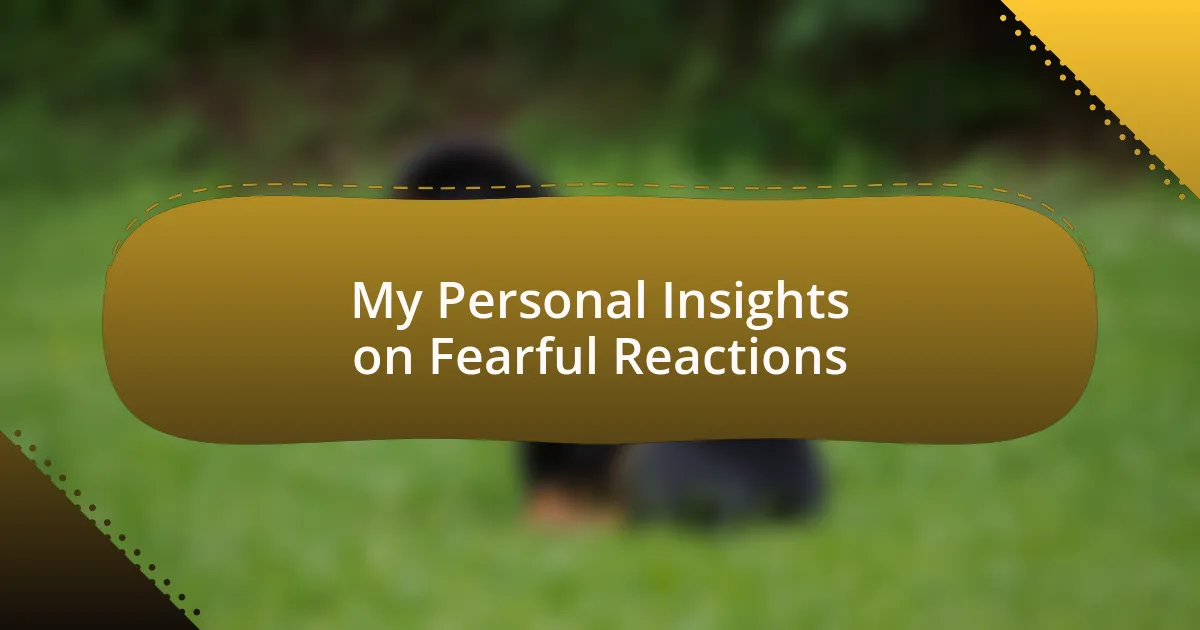Key takeaways:
- Understanding dog behavior involves interpreting emotions through body language, enhancing the bond between owners and dogs.
- Socialization is crucial during a dog’s early life to help differentiate between friendly and fearful encounters.
- Common fear triggers include loud noises, unfamiliar people, and environmental changes, which can shape a dog’s reactions.
- Managing fearful reactions can be effectively achieved through gradual desensitization, counter-conditioning, and providing a safe space.
Author: Clara Ashford
Bio: Clara Ashford is an acclaimed author known for her evocative storytelling and richly drawn characters. With a background in psychology and literature, she weaves complex narratives that explore the human experience and emotional depth. Her debut novel, Whispers in the Wind, captivated readers and critics alike, earning her a place among contemporary voices in fiction. Clara resides in the Pacific Northwest, where the lush landscapes inspire her writing. When she’s not crafting her next tale, she enjoys hiking, painting, and engaging with her vibrant community of fellow writers.
Understanding dog behavior basics
When I first adopted my rescue dog, I quickly learned that understanding dog behavior is more than just observing their actions; it’s about interpreting the emotions behind those actions. For instance, when my dog would cower in the corner during thunderstorms, I realized that his fear wasn’t just noise-related but rooted in something deeper. Have you ever noticed how a simple wag of the tail can mean so many things? This is where understanding canine body language comes into play.
I remember the moment I grasped that dogs communicate through their body language just like we do with words. For example, when my dog lifted his paw hesitantly, I paused to assess what he needed. Was he inviting me to play, or was he feeling insecure? This moment taught me that being attuned to these signals helps build a stronger bond between us. Isn’t it fascinating how much they can convey without uttering a sound?
As I immersed myself in studying dog behavior, I discovered the significance of socialization in a dog’s early life. A well-socialized pup can distinguish between friendly and fearful encounters, which is crucial for their development. Reflecting on my experience, I often wonder: how many fearful reactions could be avoided if owners invested time in socializing their dogs properly? It’s a thought that motivates me to share insights on fostering a positive environment for our furry companions.
Common triggers for fearful reactions
Common triggers for fearful reactions can vary widely from dog to dog, but I’ve noticed some patterns in my experience. For example, my dog once had a strong adverse reaction to vacuum cleaners. Seeing him dart under the couch made me realize how overwhelming that loud noise and sudden movement can be for him. Have you ever wondered what your pet must feel when exposed to such everyday appliances?
Another common trigger I’ve observed is unfamiliar people or sudden movements. I recall a time when a friend unexpectedly stopped by, and my dog, who usually greets visitors with enthusiasm, immediately turned tail and hid. It struck me how past experiences can shape their perceptions. I often think about how each new encounter is a chance to either reinforce their confidence or foster further anxiety.
Certain environmental changes can also be startling for dogs. I remember when we moved to a new neighborhood, and my pup was overwhelmed by the new sights and sounds. It was eye-opening to see how something as simple as a bustling street could lead to a fearful reaction. These experiences reinforce the importance of gradual introductions to new stimuli, wouldn’t you agree?
Strategies to manage fearful reactions
One effective strategy for managing fearful reactions is gradual desensitization. I remember when my dog became anxious around loud thunder. I started playing recordings of thunder at a low volume during calm moments, rewarding him with treats and praise when he remained relaxed. Slowly increasing the volume helped him form positive associations rather than fearful ones. Have you thought about how small, manageable steps can create significant change over time?
Another approach is counter-conditioning, which involves changing a dog’s emotional response to a trigger. I had a friend whose dog was terrified of bicycles. Whenever they approached, he would bolt for cover. My friend worked on rewarding her dog with high-value treats whenever a bicycle passed at a distance, gradually decreasing that distance as he became more comfortable. It made me realize how powerful positive reinforcement can be in shifting a dog’s perception of fear.
Creating a safe space can also work wonders for anxious pups. I’ve established a cozy corner in my home where my dog feels secure. When he shows signs of fear, inviting him to this retreat helps him calm down. Have you considered how important it is for dogs to have a designated ‘safe haven’ where they can escape overwhelming situations?

Leave a Reply